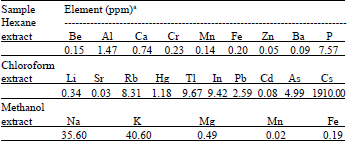Research Article
Chemical Constituents and Antioxidant Activity of Hydnophytum formicarum Jack.
Center for Innovation Development and Technology Transfer, Faculty of Medical Technology, Mahidol University, Bangkok 10700, Thailand
R. Pingaew
Department of Chemistry, Faculty of Science, Srinakharinwirot University, Bangkok 10110, Thailand
V. Yamkamon
Center for Innovation Development and Technology Transfer, Faculty of Medical Technology, Mahidol University, Bangkok 10700, Thailand
A. Worachartcheewan
Center of Data Mining and Biomedical Informatics, Faculty of Medical Technology, Mahidol University, Bangkok 10700, Thailand
S. Wanwimolruk
Center for Innovation Development and Technology Transfer, Faculty of Medical Technology, Mahidol University, Bangkok 10700, Thailand
S. Ruchirawat
Chulabhorn Research Institute and Chulabhorn Graduate Institute, Bangkok 10210, Thailand
V. Prachayasittikul
Department of Clinical Microbiology and Applied Technology, Faculty of Medical Technology, Mahidol University, Bangkok 10700, Thailand










